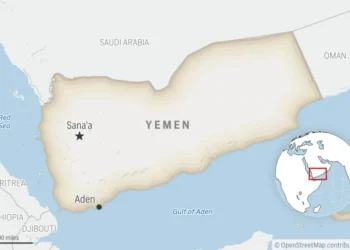North Korea has fired a ballistic missile toward the east coast, marking its first test in five months, South Korea’s military said Wednesday. The launch occurred just days before global leaders are scheduled to convene in South Korea for the Asia-Pacific Economic Cooperation (APEC) summit — an event aimed at fostering regional economic collaboration.
South Korea’s Joint Chiefs of Staff confirmed that the missile was launched eastward and landed in waters between the Korean Peninsula and Japan. No damage to neighboring countries was reported, and further details such as flight range and altitude were not immediately disclosed.
Strategic Timing Before APEC Summit
The launch comes at a sensitive moment for regional diplomacy. South Korea is preparing to host the APEC summit in Gyeongju from October 30 to November 1, where discussions will focus on economic integration and trade. Although the event does not include military components, it attracts significant geopolitical attention due to the participation of global leaders.
Former U.S. President Donald Trump was expected to visit South Korea ahead of the summit for bilateral meetings with Chinese President Xi Jinping and South Korean President Lee Jae Myung. However, South Korean officials have indicated that Trump is unlikely to attend the main conference.
Analysts suggest that Pyongyang’s missile launch could be intended as a show of strength to reinforce its demand for recognition as a nuclear weapons state. “North Korea often stages such provocations ahead of major diplomatic gatherings to assert its relevance and bargaining power,” said a defense expert from Seoul National University.
Pattern of Missile Activity and Diplomatic Maneuvering
Wednesday’s test marks North Korea’s first missile launch since May 8, when it tested short-range systems simulating nuclear counterstrikes against U.S. and South Korean forces. It is also the first test conducted under President Lee’s administration, which took office in June with a pledge to promote peace and stability on the Korean Peninsula.
North Korean leader Kim Jong Un has intensified weapons development since diplomatic talks with Trump collapsed in 2019 over the issue of U.S.-led economic sanctions. The breakdown of negotiations marked a turning point, pushing Pyongyang to prioritize military capability over dialogue.
In recent months, however, Kim has signaled a conditional openness to returning to talks if Washington abandons its demand for full denuclearization — a key sticking point in past negotiations. Trump, for his part, has expressed optimism about potential renewed diplomacy.
Showcasing Military Power and International Alignment
Earlier this month, Pyongyang unveiled a new intercontinental ballistic missile (ICBM) during a grand military parade marking the 80th anniversary of the ruling Workers’ Party. The event was attended by high-profile guests, including Chinese President Xi Jinping and Russian President Vladimir Putin, underscoring North Korea’s growing alignment with Beijing and Moscow amid ongoing global tensions.
State media described the newly displayed Hwasong-20 ICBM as North Korea’s “most powerful nuclear strategic weapon system.” Defense analysts believe the missile is designed to carry multiple nuclear warheads, making it capable of overwhelming U.S. missile defenses. Experts also warned that Pyongyang could conduct a test launch of the weapon in the coming months.
“The display of the Hwasong-20 sends a clear message: North Korea intends to solidify its status as a nuclear power,” said Dr. Park Jae-hyun, a Seoul-based military analyst. “By showcasing advanced systems, Kim aims to enhance his leverage in any future negotiations with Washington.”
Growing Diplomatic Ambitions
North Korea’s recent activities appear to be part of a broader strategy to elevate Kim Jong Un’s international stature. His joint appearances with Xi and Putin at regional events have reinforced an image of Pyongyang’s engagement with global powers despite ongoing UN sanctions and diplomatic isolation.
For Seoul, the missile launch represents a renewed security challenge. President Lee’s administration has emphasized both deterrence and dialogue, seeking to balance military preparedness with the pursuit of peace. The South Korean government has condemned the launch, calling it a violation of United Nations Security Council resolutions that prohibit North Korea from testing ballistic missile technologies.
International observers are watching closely to see whether the latest provocation leads to renewed tensions or renewed diplomatic overtures. While Washington and Seoul have maintained that denuclearization remains the goal, Pyongyang’s insistence on nuclear state recognition continues to complicate negotiations.
Regional and Global Implications
The timing of the missile launch, just before a major multilateral economic summit, adds to geopolitical uncertainty in East Asia. Japan, the United States, and South Korea have stepped up trilateral security coordination in recent months, citing North Korea’s evolving nuclear and missile capabilities as a shared concern.
The United Nations, meanwhile, has warned that North Korea’s continued weapons testing undermines regional stability and diverts resources from urgent humanitarian needs within the country. According to the UN World Food Programme, North Korea faces ongoing food shortages affecting millions of its citizens.
Despite growing global condemnation, Pyongyang remains defiant, viewing its missile program as essential to national defense and regime survival. As the APEC summit approaches, attention will turn to how regional leaders respond — and whether this latest test signals a new phase in North Korea’s long-standing strategy of provocation and negotiation.
Source: AP News – North Korea has fired a ballistic missile toward the east, Seoul says
This article was rewritten by JournosNews.com based on verified reporting from trusted sources. The content has been independently reviewed, fact-checked, and edited for accuracy, tone, and global readability in accordance with Google News standards.
Stay informed with JournosNews.com — your trusted source for verified global reporting and in-depth analysis. Follow us on Google News and BlueSky for real-time updates.
JournosNews.com follows Google News content standards with original reporting, verified sources, and global accessibility. Articles are fact-checked and edited for accuracy and neutrality.













